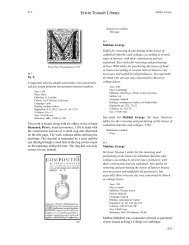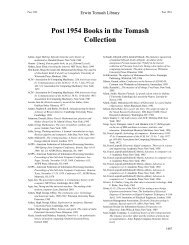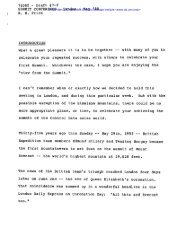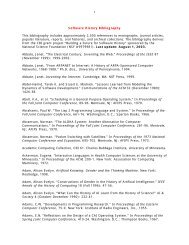B chapter.indd - Charles Babbage Institute - University of Minnesota
B chapter.indd - Charles Babbage Institute - University of Minnesota
B chapter.indd - Charles Babbage Institute - University of Minnesota
You also want an ePaper? Increase the reach of your titles
YUMPU automatically turns print PDFs into web optimized ePapers that Google loves.
Erwin Tomash Library<br />
Bowditch, <strong>Charles</strong> Pickering Bowditch, Nathaniel<br />
Collation: π 9 (-π10)1–20 8 21 6 22 7 (-22 8 )[23] 19 (-23 20 )<br />
Size: 253x165 mm<br />
<strong>Charles</strong> P. Bowditch was the man who founded the<br />
Maya collections <strong>of</strong> the Peabody Museum at Harvard<br />
<strong>University</strong> and the person after whom their Bowditch<br />
pr<strong>of</strong>essorship is named.<br />
The system <strong>of</strong> numeration used by a civilization is not<br />
a machine, but it certainly is machinery. Without it very<br />
little could be accomplished in the way <strong>of</strong> numeration<br />
or, especially, arithmetic; because <strong>of</strong> this, works on<br />
numeration are <strong>of</strong> particular interest to this collection.<br />
This work was one <strong>of</strong> the first attempts to systematically<br />
set forth the numeration and calendar systems <strong>of</strong> the<br />
Maya. It not only explains them but also examines all<br />
extant Maya material for examples <strong>of</strong> the glyphs used<br />
and their interpretation.<br />
Illustrations available:<br />
Title page<br />
Examples <strong>of</strong> Maya numeration<br />
Maya numeration, B 215<br />
B 215<br />
B 216<br />
Bowditch, Nathaniel (1773–1838)<br />
The new American practical navigator<br />
Year: 1802<br />
Place: Newburyport, MA<br />
Publisher: Edmund M. Blount for Brown & Stansbury, New<br />
York<br />
Edition: 1st<br />
Language: English<br />
Figures: 1 engraved folding frontispiece chart, 7 engraved<br />
plates (1 tinted)<br />
Binding: contemporary leather; rebacked; red leather label<br />
Pagination: pp. 246, [274], 533–589, [15]<br />
Collation: A–2H 4 A–B 4 (A)–(2S) 4<br />
Size: 224x133 mm<br />
Reference: Glais RCMT, p. 89; not in Karp MWPA<br />
Nathaniel Bowditch was a self-educated seaman and<br />
mathematician who had only three years <strong>of</strong> schooling<br />
when he began working in his father’s cooper’s shop at<br />
the age <strong>of</strong> ten. Later he was apprenticed to a firm <strong>of</strong> ship’s<br />
chandlers who encouraged his mathematical interests. At<br />
the age <strong>of</strong> twenty-two he became a seaman and spent the<br />
next nine years aboard ship, sailing on long voyages to<br />
the Caribbean, Portugal and the East Indies.<br />
In the course <strong>of</strong> these voyages, Bowditch became<br />
celebrated as a skilled navigator and found himself<br />
spending long hours correcting the navigational tables<br />
then in use. He then turned his attention to the standard<br />
navigational text <strong>of</strong> his time, John Hamilton Moore’s The<br />
practical navigator and seaman’s new daily assistant,<br />
London, 1772. He completely reworked and extended<br />
Moore’s book and decided to publish his revised version<br />
as The new American practical navigator, a title clearly<br />
reflecting its heritage. This work is much more than an<br />
improved set <strong>of</strong> navigational tables, for it also contains<br />
useful sections ranging from a short dictionary <strong>of</strong> sea<br />
terms to explanations <strong>of</strong> the parts <strong>of</strong> a ship (see the<br />
illustration <strong>of</strong> the colored plate and its text). Also included<br />
are standard forms for various contracts for freight and<br />
charters and other financial and legal documents.<br />
Bowditch found and corrected some eight thousand<br />
errors in the Moore version <strong>of</strong> the tables. Most were <strong>of</strong><br />
little consequence, but some were quite significant. For<br />
example, Moore’s incorrect identification <strong>of</strong> 1800 as a<br />
leap year introduced a twenty-three mile error in some<br />
results and caused the loss <strong>of</strong> both ships and men.<br />
Bowditch’s reputation as a legendary navigator was<br />
reinforced when Harvard <strong>University</strong> awarded him an<br />
honorary M.A. degree. He knew nothing <strong>of</strong> this honor,<br />
but being stranded in the port <strong>of</strong> Boston by adverse winds,<br />
he serendipitously decided to visit Harvard. Finding its<br />
graduation ceremonies in progress, he sat in the audience<br />
183







